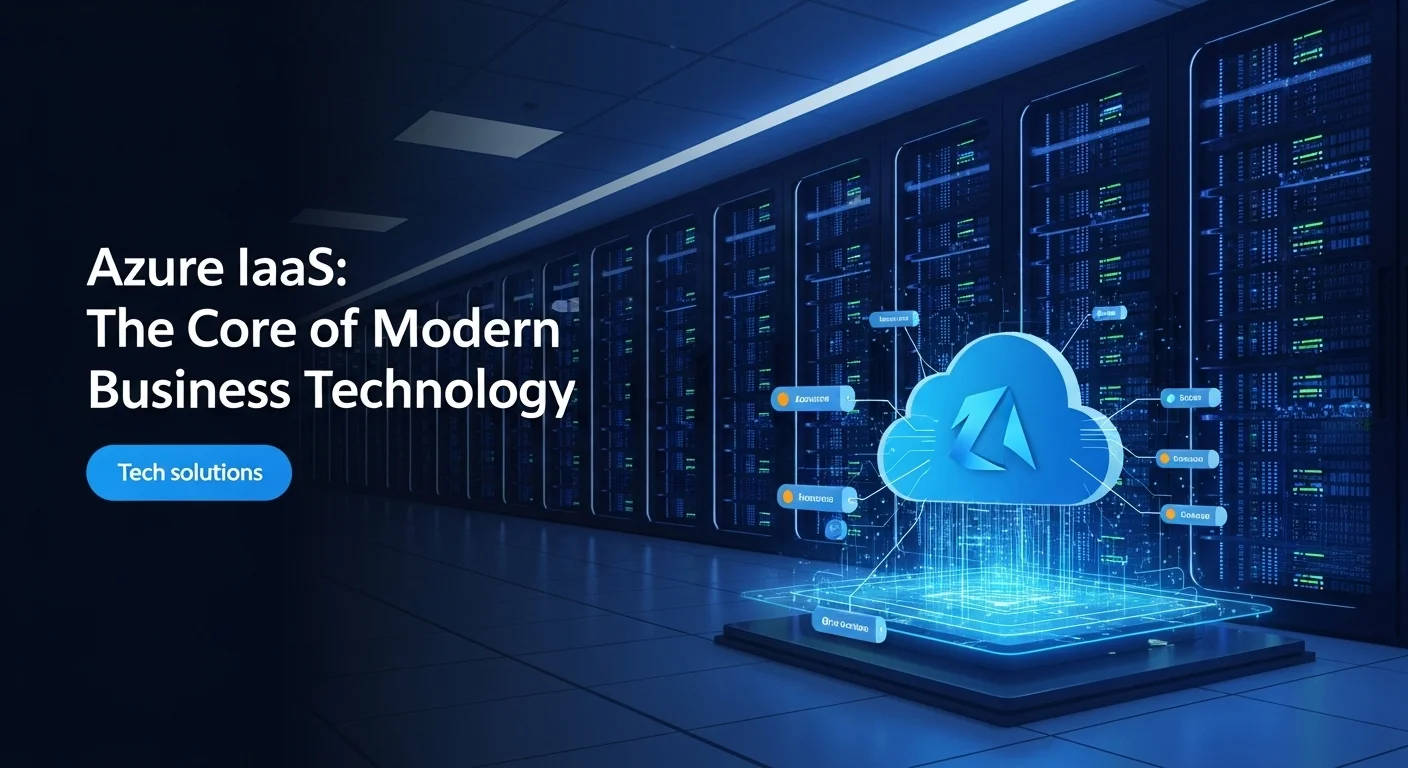Azure IaaS Explained: Your Guide to Building a Powerful Cloud Foundation

Executive Summary
Over my years as a cloud architect, I've seen countless businesses make the leap to the cloud. The journey almost always starts with one fundamental concept: Infrastructure as a Service, or IaaS. It’s the bedrock of any solid cloud strategy, and Microsoft's Azure IaaS is one of the most powerful platforms out there. This article is my personal guide to demystifying it. We'll cut through the jargon to understand what IaaS really is and how it differs from other models like PaaS. I’ll share my insights on Azure's key products—from virtual machines to networking—and bring it all to life with practical, real-world examples I've seen in the field. Whether you're running a small business or managing IT for a large enterprise, my goal is to give you the clear, straightforward knowledge you need to harness Azure IaaS, streamline your operations, and truly innovate.
Table of Contents
Table of Contents
- What is Azure IaaS and Why Does It Matter?
- The Old Way vs. The New Way: IaaS vs. On-Premises
- The Critical Difference: Azure IaaS vs. PaaS
- A Look Inside the Toolbox: Azure IaaS Products
- Azure IaaS in Action: Real-World Stories
What is Azure IaaS and Why Does It Matter?
In today's fast-paced digital world, companies need to be quick on their feet. The old way of managing technology—buying and maintaining rooms full of physical servers—is often too slow and expensive. This is where Infrastructure as a Service (IaaS) completely changes the game, with Microsoft's Azure platform leading the charge. IaaS is a cloud computing service where, instead of owning your IT hardware, you essentially rent it over the internet from a provider like Microsoft. I’ve always explained it to my clients like this: think of it as renting a professional, fully-equipped kitchen instead of building one from scratch. You get all the high-end ovens, stovetops, and workspaces (servers, storage, networking) on a pay-as-you-go basis. This shift from a massive upfront investment to a manageable operating cost gives businesses incredible flexibility. Its importance can't be overstated; Azure IaaS is the foundation on which modern digital businesses are built, allowing them to scale, innovate, and focus on what they do best, rather than worrying about managing hardware.
The Old Way vs. The New Way: IaaS vs. On-Premises
To really appreciate what Azure IaaS offers, let's look at the traditional on-premises model. I’ve walked through many company-owned data centers, and the story is always the same. The business is responsible for everything: buying the physical servers, finding a space to house them, paying for the power and cooling, and hiring a team to manage it all. It’s a huge upfront cost and a constant maintenance headache. Azure IaaS takes all of that physical burden away. Microsoft manages the global data centers, the hardware, and the core network fabric. As the customer, you get to access all these resources virtually. With a few clicks, you can launch a virtual server (a VM), set up your storage, and design a secure network. You get the raw materials for computing without the physical baggage. This is the core idea of Azure's cloud infrastructure—providing the essential building blocks on demand.
The Critical Difference: Azure IaaS vs. PaaS
In the cloud world, you’ll hear the terms IaaS and PaaS (Platform as a Service) a lot, and it’s crucial to know the difference. The relationship between Azure IaaS and PaaS is something I clarify for clients all the time. The best way to think about it is my 'Pizza as a Service' analogy. IaaS is like getting a professional kitchen with all the raw ingredients (flour, tomatoes, cheese). You have total control to make your pizza exactly how you want, from the dough to the toppings, but you're responsible for making it. This is perfect for moving existing applications to the cloud or when you need deep control over the operating system. PaaS, on the other hand, is like ordering a pizza for delivery. The pizza place (Microsoft) handles the kitchen, the ingredients, and the baking. You just get the finished pizza delivered to your door and eat it. You're only responsible for the final product (your app and data). PaaS services like Azure App Service are amazing for developers who just want to write code without managing servers. The real magic happens when you realize you don't have to choose. The most powerful solutions often use both Azure IaaS and PaaS together. For example, a web app might run on a PaaS service for easy scaling, while its specialized database runs on an IaaS virtual machine for maximum control.
A Look Inside the Toolbox: Azure IaaS Products
Microsoft Azure provides a rich toolbox of IaaS products that let you build just about anything. The star of the show is Azure Virtual Machines (VMs). These are your workhorse servers in the cloud, available for both Windows and Linux, ready to go in minutes. I've seen clients use them for everything from simple web servers to complex data analysis. Azure offers a huge variety of VM sizes, so you can pick the right power for the right job and price. Of course, those VMs need a place to store data. That's where Azure Storage comes in. It's not one-size-fits-all; you have options like Blob Storage for massive amounts of unstructured data (like images or videos), Disk Storage for high-speed access for your VMs, and Azure Files for shared network drives in the cloud. The glue holding it all together is Azure Virtual Network (VNet). This lets you carve out your own private, isolated section of the Azure cloud, where you can define your own network layout, just like you would on-premises. Services like Azure Load Balancer act as traffic cops, distributing incoming requests across multiple VMs to keep your app running smoothly and prevent overloads.
Azure IaaS in Action: Real-World Stories
The real value of Azure IaaS becomes clear when you see how companies use it. I remember a startup client that needed environments for their developers to build and test new features. Instead of buying expensive hardware that would sit idle half the time, they used Azure to spin up dev/test environments on demand and shut them down at the end of the day, paying only for what they used. The savings were massive. Another common use I see is hosting websites and applications. A retail company I worked with hosts their e-commerce site on Azure VMs. Using a feature called Scale Sets, their site automatically adds more VMs to handle the Black Friday rush and then scales back down when traffic is normal, ensuring a great customer experience without overpaying for capacity. And for really heavy-duty tasks, like financial risk modeling or scientific research, Azure offers high-performance computing (HPC) VMs that are essentially supercomputers on demand. Finally, one of the most critical uses is Backup and Disaster Recovery. Using Azure Site Recovery, businesses can create a live replica of their entire on-premises infrastructure in Azure. If a disaster like a fire or flood hits their primary data center, they can fail over to Azure in minutes and keep the business running. These examples of IaaS in Azure show it’s more than just technology; it's a powerful tool for solving real business problems.

A Deeper Dive: Mastering Azure IaaS for Business Solutions
Once you've grasped the basics, you can start combining Azure's IaaS tools to build truly powerful solutions for your business. This is where my job gets really interesting—moving beyond just 'what it is' to 'what you can do with it'. This guide is about the strategy, the architecture, and the business thinking required to leverage the Azure cloud IaaS platform effectively. To truly get ahead, you need to think like an architect, balancing cost, performance, and security. We'll break down the techniques for designing robust systems and show how a smart mix of services can give you a real competitive edge.
Designing for Success: Architecture and Best Practices
Building on Azure isn't just about launching a VM; it's about thoughtful design. Microsoft provides a fantastic guide called the Azure Well-Architected Framework. I always tell my clients to think of it as a checklist of smart questions to ask yourself across five key areas: Cost, Operations, Performance, Reliability, and Security. For reliability, a core technique is using Availability Sets and Availability Zones. Think of an Availability Set as telling Azure, 'Hey, these two VMs are part of the same application, so please don't put them on the same physical server rack.' That way, if one rack fails, your app stays online. Availability Zones take it a step further. It's like having your servers in two completely separate buildings with their own power and cooling. It's your best defense against a large-scale outage in a single data center. For performance, it’s all about matching the tool to the job. You wouldn't use a scooter to haul lumber. Similarly, you choose a memory-optimized VM for a big database, not a general-purpose one. And for storage, you'd use a high-speed Premium SSD for that database's files, but a cheaper Standard HDD for backups. The real pro-move here is automation. Using Azure Resource Manager (ARM) templates lets you define your entire infrastructure in a code file. I’ve helped teams deploy complex, multi-server environments in minutes, perfectly, every single time. It eliminates human error and makes your deployments fast and repeatable.
The Hybrid Power Play: Combining IaaS and PaaS
I often see people get stuck debating Azure IaaS vs. PaaS, but that’s the wrong way to look at it. The smartest solutions I've built recognize it's a spectrum, and the goal is to mix and match. The principle is simple: use the service that does the most heavy lifting for you for any given task. Let's go back to that e-commerce application. The customer-facing website is a perfect fit for Azure App Service (a PaaS offering). It scales automatically during sales, and developers don't have to worry about patching the underlying operating system. They just focus on the website's code. But let's say the site connects to an old, custom-built inventory system that only runs on a specific version of Windows Server. That’s a job for an Azure IaaS VM. It gives you the full control needed to get that legacy piece working. This combination of Azure IaaS and PaaS is the best of both worlds: you get the speed and convenience of PaaS for the new stuff, and the control and compatibility of IaaS for the tricky parts. It's a pragmatic and incredibly effective approach.
Choosing Your Cloud Partner: Azure vs. The Competition
In the cloud space, Azure's main competitors are Amazon Web Services (AWS) and Google Cloud Platform (GCP). All three are fantastic platforms, but they have different strengths. From my experience, Microsoft’s ace in the hole is its integration with the enterprise world. If your company already runs on Windows Server, uses Office 365, and manages users with Active Directory, Azure feels like a natural extension of your existing data center. The Azure Hybrid Benefit is a huge deal here—it lets you use your existing on-premises Windows and SQL Server licenses in the cloud, which can save a tremendous amount of money. It’s a compelling reason for many established businesses to choose Azure. When you look at the core services, they are all competitive. Azure VMs are comparable to AWS EC2, and Azure Blob Storage is similar to AWS S3. Where Azure has made huge strides is in areas like its Azure Kubernetes Service (AKS) for managing containers, which is now a top-tier offering. Ultimately, the choice often comes down to what your team already knows and what your specific business needs are. But for any organization with a Microsoft footprint, the synergy between their existing investments and the rich portfolio of Azure IaaS products creates a powerful 'home-field advantage'.
Your Toolkit for Success: Azure Resources and Solutions
Microsoft doesn't just give you the tools; it gives you the instruction manual and a support system. The Azure documentation is incredibly thorough. For bigger-picture strategy, I always point people to the Azure Architecture Center, which is filled with proven designs for common scenarios. When you're ready to make the move, a tool called Azure Migrate is your best friend. It analyzes your on-premises servers and gives you a detailed plan for moving them to Azure, including cost estimates and recommended VM sizes. Once you're in the cloud, tools like Azure Cost Management + Billing are essential for keeping an eye on your spending. My favorite tool, though, is Azure Advisor. It's like having a free cloud consultant on your team. It analyzes your setup and gives you personalized recommendations to improve security, boost performance, and, most importantly, save money. The solutions built on this platform are everywhere: retailers handling holiday traffic spikes, banks running complex financial models, and hospitals hosting secure patient data, all leveraging Azure’s power and compliance to innovate and grow.

Mastering the Craft: Pro Tips for Your Azure IaaS Experience
Getting your infrastructure running on Azure is just the beginning. The real art lies in refining and optimizing it over time. To get the most out of your investment, you need to think continuously about cost, security, and performance. In this section, I’ll share some of the most impactful tips and strategies I've learned over the years. These are the practices that separate a basic cloud setup from a truly efficient, secure, and well-managed environment. Let's explore the tools and techniques that will help you master your Azure IaaS journey.
Don't Break the Bank: Cost Optimization Tips and Tools
The first cloud bill can often be a surprise for new users. Let's make sure it's a pleasant one. The most common mistake I see is over-provisioning—paying for more power than you need. The number one rule is to right-size your resources. Use tools like Azure Monitor and Azure Advisor to see how much CPU and memory your VMs are actually using. Advisor will often point out VMs that are sitting idle or are too large for their workload, offering a quick win on savings. Next, get smart about how you pay. For servers that you know will be running 24/7, use Azure Reservations. By committing to a one- or three-year term, you can get a massive discount compared to the pay-as-you-go price. For workloads that can be interrupted, like batch processing jobs, check out Azure Spot Virtual Machines. You get to use Azure's spare compute capacity for up to 90% off—it's an incredible deal. Another huge money-saver is automation. Your dev and test environments don't need to run overnight or on weekends. I always help my clients set up simple scripts that automatically shut these VMs down outside of business hours. This one practice can easily cut your non-production costs in half. Finally, get disciplined with tagging. By tagging every resource with a project or department name, you can use Azure Cost Management to see exactly where your money is going, making it easy to create budgets and identify waste.
Locking it Down: Security and Governance in IaaS
In the cloud, security is a partnership. Microsoft secures the physical data center, but you are responsible for securing what you put inside it. A non-negotiable first step is network security. Use Network Security Groups (NSGs) as a basic firewall for your VMs, only opening the specific ports you need. Please, never expose management ports like RDP or SSH directly to the internet. Instead, use Azure Bastion. It’s a service that acts as a secure, managed jump-box, letting you connect to your VMs through the Azure portal without needing a public IP address. It's like a secure, secret entrance for your IT staff. On the identity front, always use Azure Active Directory (Azure AD) and enforce Multi-Factor Authentication (MFA) for anyone with admin rights. It's the single most effective thing you can do to prevent unauthorized access. Use Azure Role-Based Access Control (RBAC) to give people only the permissions they need to do their job, nothing more. For a bird's-eye view of your security, use Microsoft Defender for Cloud. It constantly scans your environment and gives you a prioritized list of security recommendations, like missing patches or insecure configurations. To enforce your rules, Azure Policy is your best friend. You can create policies to, for example, block the creation of expensive VM types or ensure that every storage account is encrypted. It’s your tool for making sure everyone plays by the rules.
Keeping It Fast and Stable: Performance and Reliability
A slow or unreliable application is a failing application. For performance, especially with databases, don't skimp on storage. Using Premium SSDs provides the low latency and high I/O operations per second (IOPS) that these workloads demand. Also, enable Accelerated Networking on your VMs. It's a simple checkbox that dramatically improves network speed by letting your VM talk directly to the underlying hardware. To handle traffic and improve reliability, use a load balancer. Azure Load Balancer is great for simple traffic distribution, while Azure Application Gateway is a more advanced option that can handle things like SSL offloading and provides a Web Application Firewall (WAF) to protect against common web attacks. The key to reliability is designing for failure. As we discussed, deploying your critical VMs across multiple Availability Zones is your best protection against a data center-level issue. For web servers, I always recommend VM Scale Sets. This feature lets you group identical VMs and set up rules to automatically add more instances when traffic is high and remove them when it's quiet. Proactive monitoring is also essential. Use Azure Monitor to set up alerts for things like high CPU usage or low disk space. It’s much better to get an alert and fix a problem before your users ever notice it.
Connecting Your Worlds: Hybrid Capabilities and Further Learning
Most companies I work with don't live 100% in the cloud. They have a hybrid environment with resources on-premises and in Azure. Azure was built for this reality. A game-changing technology here is Azure Arc. It essentially extends the Azure management plane to your own data center. You can use it to apply Azure policies and security controls to your on-premises servers, managing your entire hybrid estate from a single control panel. For networking, a secure VPN is a good start, but for serious, high-speed connectivity, Azure ExpressRoute is the way to go. It provides a private, dedicated link between your office and Azure, offering far better performance and reliability than a connection over the public internet. The journey with Azure is one of continuous learning. To go deeper, I highly recommend digging into the official Microsoft Azure Well-Architected Framework documentation. It is an invaluable resource that details all the principles we've discussed. By applying these advanced strategies and exploring the many examples of IaaS in Azure, you can elevate your cloud practice from simple hosting to a true engine for business innovation.
Expert Reviews & Testimonials
Sarah Johnson, Business Owner ⭐⭐⭐
As a business owner, I found the information on Azure IaaS accurate. I just wish there were a few more practical examples tailored for people like me, not just tech experts.
Mike Chen, IT Consultant ⭐⭐⭐⭐
This was a helpful article on Azure IaaS that definitely cleared some things up for me. Some of the technical concepts could still be a bit simpler, but overall, it was a good read.
Emma Davis, Tech Expert ⭐⭐⭐⭐⭐
Absolutely fantastic article! It's incredibly comprehensive on Azure IaaS and was a huge help for my specialization. Everything was explained perfectly and I understood it all.



